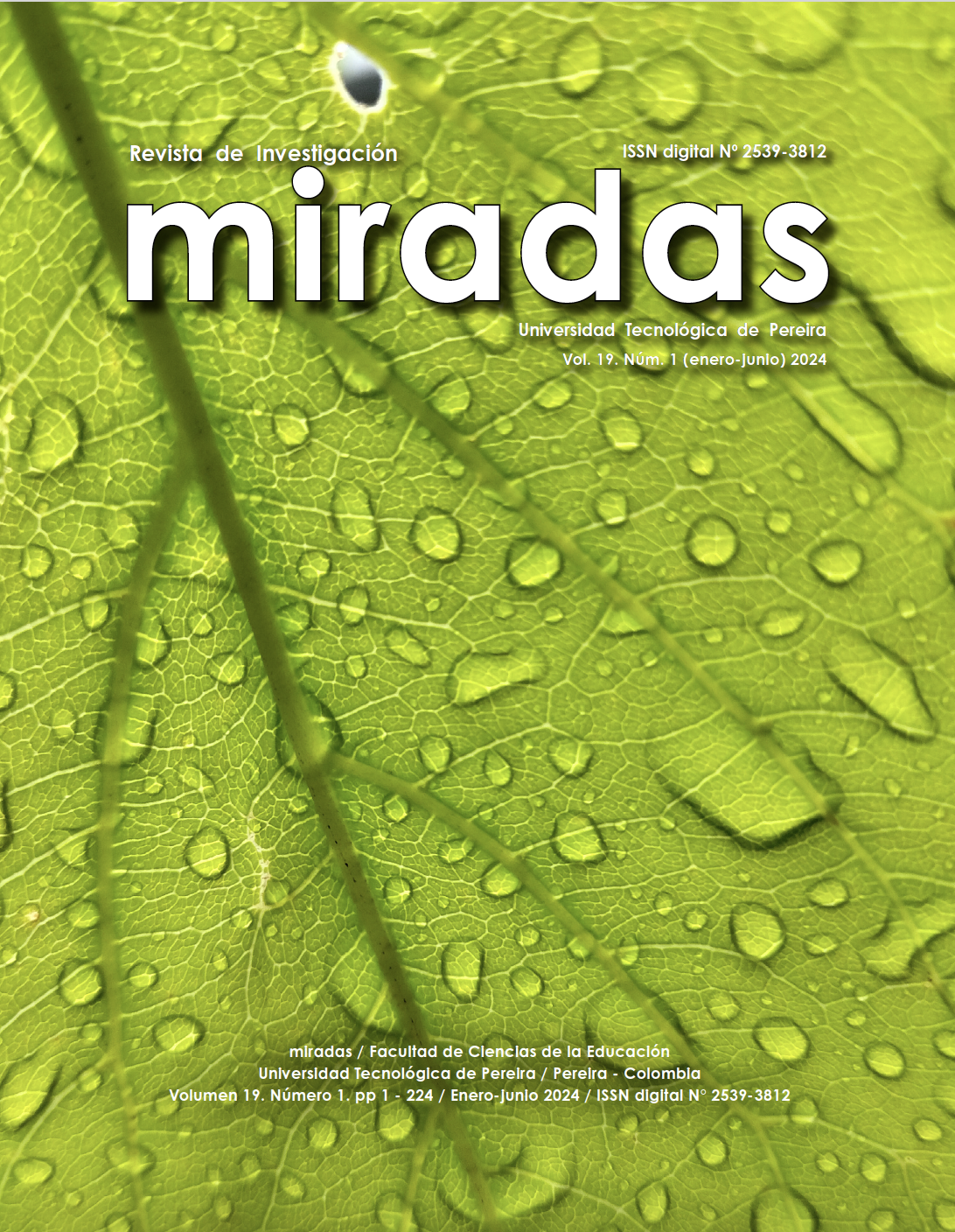Uso de la L1 en el aula de L2 en la enseñanza superior
DOI:
https://doi.org/10.22517/25393812.25402Resumen
El uso de la L1 en el aula es un problema que todos los maestros han enfrentado porque no está claro cuándo y cómo usar el primer idioma cuando se enseña un segundo idioma. En este orden de ideas, se ha realizado esta investigación descriptiva para determinar cómo y cuándo los profesores de educación superior utilizan el primer idioma cuando enseñan inglés como segundo idioma. La población es de 22 profesores que trabajan con adultos jóvenes y adultos pertenecientes a la licenciatura en universidades públicas y Centros de Idiomas en Tuxtla Gutiérrez, Chiapas, México. El instrumento aplicado es una encuesta aplicada en línea, con cinco preguntas. Los resultados concluyen que no todos los profesores utilizan la primera lengua en el aula y piensan que el uso de la L1 es incorrecto porque no promueve la L2 en los estudiantes y no tienen suficiente práctica. Por otro lado, la mayoría de los profesores que participaron en esta investigación están de acuerdo con el uso de L1 para las explicaciones; y para ahorrar tiempo, especialmente cuando los grupos son grandes, en general, cuando los estudiantes son principiantes. Esta discusión continúa abierta además sobre el tiempo que los profesores deben usar o no usar la L1 durante las lecciones porque según los datos obtenidos, algunos de los profesores usan la L1 menos de 15 minutos, pero los medios de comunicación son alrededor de 15-30 minutos promedio en una hora, lo que podría representar un problema. Por lo tanto, es importante reflexionar sobre el tema para aprender a tratarlo y tomar la mejor decisión para mejorar la confianza y el conocimiento de los estudiantes sobre la L2.
Descargas
Citas
Almoayidi, K. A. (2018). The effectiveness of using L1 in second language classrooms: A controversial issue. Theory and Practice in Language Studies, Vol. 8, No. 4, pp. 375-379. Retrieved in
DOI: http://dx.doi.org/10.17507/tpls.0804.02
Alton, M. (2021). Code-Switching in L2 Classrooms: A Useful Strategy to Reinforce
Learning. Canadian Journal of Language and Literature Studies. Vol. 1,1, pp. 21-26. Retrieved in https://www.cjlls.ca/index.php/cjlls/article/download/13/9
Bensen, H. (2013). Reason for the teachers’ uses of code switching in adult EFL classrooms. Sayt. 20,2. 69-82. Retrieved in https://www.hayefjournal.org/Content/files/sayilar/63/69.pdf
Beressa, K. (2003). Using L1 in The EFL Classroom: The Case of The Oromo Language With Particular Reference to Adama Teachers College. Addis Ababa University.
Cadena, B., Damián, D., Tacoaman, M. (2018). Use of L1 in English as a foreign language (ELF) learning environments. Boletin Virtual. 1,6. 1-15. Retrieved in https://dialnet.unirioja.es/descarga/articulo/6523312.pdf
Cambridge (2019). The use of L1 in English Language Teaching. ELT series. Retrieved in https://languageresearch.cambridge.org/images/CambridgePapersInELT_UseOfL1_2019_ONLINE.pdf
Carson, E., Kashihara, H. (2012). Using the L1 in the L2 classroom: The students speak. The language teacher. 36-4, 41-48. Retrieved in https://jalt-publications.org/sites/default/files/pdf-article/36.4_art1.pdf
Chang, S. (2011). A Contrastive Study of Grammar Translation Method and
Communicative Approach in Teaching English Grammar. English language teaching. Vol.4, No. 2. 13-24. Retrieved in https://citeseerx.ist.psu.edu/document?repid=rep1&type=pdf&doi=a50fd0f36a25f46ab9eea56d2098827435d57415
Council of Europe (2020). Common European Framework of Reference for Languages: Learning, teaching, assessment. Companion Volume. Retrieved in https://rm.coe.int/common-european-framework-of-reference-for-languages-learning-teaching/16809ea0d4
De la Campa, J., Nassaji, H. (2009). The amount, purpose and reasons for using L1 in L2 classrooms. Foreign language annals. 42, 4. 742-759. Retrieved in
Gorbhani, A. (2011). First Language Use in Foreign Language Classroom Discourse. Procedia social and behavioral science. 29, 1654-1659.
Retrieved in https://www.researchgate.net/publication/271562100_First_Language_Use_in_Foreign_Language_Classroom_Discourse
Hancock, M. (1997). Behind classroom code switching: layering and language choice in L2 learner interaction. TESOL Quarterly, 31,2, 217-235.
Kjøstvedt, K. (2020). Investigating Teachers’ Use of L1 in L2 Teaching. University of Adger. Retrieved in https://uia.brage.unit.no/uia-xmlui/bitstream/handle/11250/2681410/Kamilla%20Kjøstvedt.pdf?sequence=1
Kwon, C. (2014). Student perspectives on group work and use of L1: academic writing in a university EFL course in Thailand. Second Language Studies. 33.1. 85-124. Retrieved in https://core.ac.uk/download/pdf/77238782.pdf
Mart, C. (2013). The Facilitating Role of L1 in ESL Classes. International Journal of Academic Research in Business and Social Sciences. Vol. 3, No. 1. 9-14. Retrieved in https://hrmars.com/papers_submitted/9445/the-facilitating-role-of-l1-in-esl-classes.pdf
Meyer, H. (2008). The Pedagogical Implications of L1 Use in the L2 Classroom. Gunma University Academic Information, 147-160. Retrieved in https://core.ac.uk/display/141876659?utm_source=pdf&utm_medium=banner&utm_campaign=pdf-decoration-v1
Rance-Roney, J. (2010). Reconceptualizing Interactional Groups: Grouping Schemes for Maximizing Language Learning.1. 20-26. Retrieved in https://americanenglish.state.gov/files/ae/resource_files/10-48-1-d_2.pdf
Saruwatashi, S. (2020). Principal Reasons for Using L1 in the L2 Classroom. Junshin Repository. Retrieved in https://core.ac.uk/download/pdf/288228893.pdf
Sundary, H., Febriyanty, R. (2021). The Use of First Language (L1) in EFL Classrooms:
Teachers’ Practices and Perspectives. International Journal of Education. 14, 1. 70-77. Retrieved in https://ejournal.upi.edu/index.php/ije/article/download/26375/pdf
Tajgozari, M. (2017) Factors Contributing to the Use of L1 in English Classrooms: Listening to the Voice of Teachers and Students in Iranian Institutes. IJREE. 2 (2). Retrieved in http://ijreeonline.com/article-1-43-en.html
Taşçı, S., & Aksu Ataç, B. (2020). L1 use in L2 teaching:The amount, functions, and perception towards the use of L1 in Turkish primary school context. International Online Journal of Education and Teaching (IOJET), 7(2), 655-667. Retrieved in https://iojet.org/index.php/IOJET/article/view/816
Turnbull, M. (2001). There is a role for the L1 in second and foreign language teaching, but . . . Canadian Modern Language Review 57, 531-540.
Wang, M. (2022). Using L1 in L2 classroom. Research and Advances in Education.Vol.1, No. 5, 45-49. Retrieved in
Yavuz, F. (2012). The Attitudes of English Teachers about the Use of L1 in the Teaching of L2. Procedia - Social and Behavioral Sciences, 46, 4339-4344. Retrieved in https://doi.org/10.1016/j.sbspro.2012.06.251
Yi-chin, P, Yi-chun, P. (2010). The use of L1 in the foreign language classroom. Colombian Applied Linguistic Journal, 12 (2), 87-96.
Retrieved in http://dx.doi.org/10.14483/22487085.85
Zulfikar, Z. (2019). Rethinking the use of L1 in L2 classroom. English Journal. 6, 1, 42-51. Retrieved in http://dx.doi.org/10.22373/ej.v6i1.2514
Descargas
-
Vistas(Views): 523
- PDF Descargas(Downloads): 247



